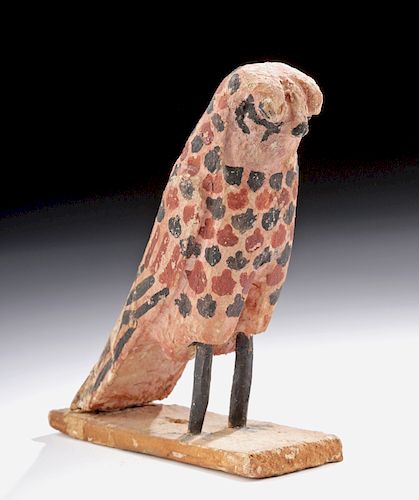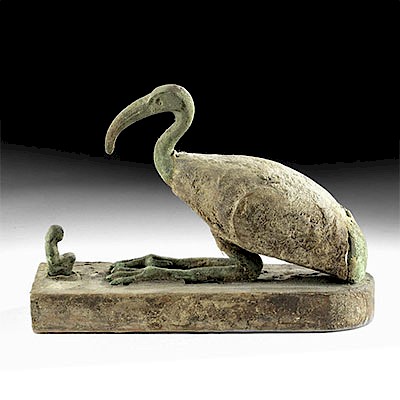Egyptian Wood w/ Painted Gesso Horus Falcon
Lot 20b
About Seller
Artemis Fine Arts
686 S Taylor Ave, Ste 106
Louisville, CO 80027
United States
Selling antiquities, ancient and ethnographic art online since 1993, Artemis Gallery specializes in Classical Antiquities (Egyptian, Greek, Roman, Near Eastern), Asian, Pre-Columbian, African / Tribal / Oceanographic art. Our extensive inventory includes pottery, stone, metal, wood, glass and textil...Read more
Estimate:
$1,000 - $1,500
Absentee vs Live bid
Two ways to bid:
- Leave a max absentee bid and the platform will bid on your behalf up to your maximum bid during the live auction.
- Bid live during the auction and your bids will be submitted real-time to the auctioneer.
Bid Increments
| Price | Bid Increment |
|---|---|
| $0 | $25 |
| $300 | $50 |
| $1,000 | $100 |
| $2,000 | $250 |
| $5,000 | $500 |
| $10,000 | $1,000 |
| $20,000 | $2,500 |
| $50,000 | $5,000 |
| $100,000 | $10,000 |
| $200,000 | $20,000 |
About Auction
By Artemis Fine Arts
Oct 31, 2019
Set Reminder
2019-10-31 10:00:00
2019-10-31 10:00:00
America/New_York
Bidsquare
Bidsquare : Fine Antiquities, Asian, Ethnographic Art
https://www.bidsquare.com/auctions/artemis-gallery/fine-antiquities-asian-ethnographic-art-4581
Our Halloween Day auction features classical antiquities, ancient and ethnographic art from cultures encompassing the globe, plus fine art. Artemis Fine Arts info@artemisfinearts.com
Our Halloween Day auction features classical antiquities, ancient and ethnographic art from cultures encompassing the globe, plus fine art. Artemis Fine Arts info@artemisfinearts.com
- Lot Description
Egypt, Late Dynastic to Ptolemaic period, ca. 664 to 30 BCE. A hand-carved wooden figurine of a falcon representing Horus, the falcon-headed god of the sky. The avian figure stands on a pair of rod-form legs that are attached to a rectangular plinth and has a broad tail, a thick body, and a perky head. Both bird and base are covered in layers of gesso and then painted with red, black, and pink pigments to form feathers, feet, and wings. Avian effigies like this example were important symbols in ancient Egypt that were used in a variety of ceremonial and cult-related events. Size: 4.4" W x 5.4" H (11.2 cm x 13.7 cm).
The ancient Egyptians believed that their pharaoh was a personification of Horus the sky god - depicted as either a falcon-headed man donning the pschent (a red and white crown) to symbolize his reign over Egypt or as the bird itself - a powerful icon of power, speed, and talent for hunting - as we see in this example. This association between Horus and the king existed from the early Dynastic period (ca. 3100 BCE); however, the Horus king cult became very popular during the Ptolemaic Period. Additionally, statues of Horus were created to adorn temples as an image of kingship - capturing an image of Horus on earth.
Provenance: private J.H. collection, Beaverton, Oregon, USA; ex-Sands of Time, Washington, D.C.; ex-private California, USA collection, acquired in the 1960s and thence by descent
All items legal to buy/sell under U.S. Statute covering cultural patrimony Code 2600, CHAPTER 14, and are guaranteed to be as described or your money back.
A Certificate of Authenticity will accompany all winning bids.
We ship worldwide and handle all shipping in-house for your convenience.
#149840Figure is removable from legs, and legs are removable from rectangular plinth. Minor nicks and abrasions to head, body, tail, and base, with fading to original pigmentation, and chipping to areas of gesso. Nice traces of original painted gesso throughout.Condition
- Shipping Info
-
All shipping is handled in-house for your convenience. Your invoice from Artemis Gallery will include shipping calculation instructions. If in doubt, please inquire BEFORE bidding for estimated shipping costs for individual items.
-
- Buyer's Premium



 EUR
EUR CAD
CAD AUD
AUD GBP
GBP MXN
MXN HKD
HKD CNY
CNY MYR
MYR SEK
SEK SGD
SGD CHF
CHF THB
THB















